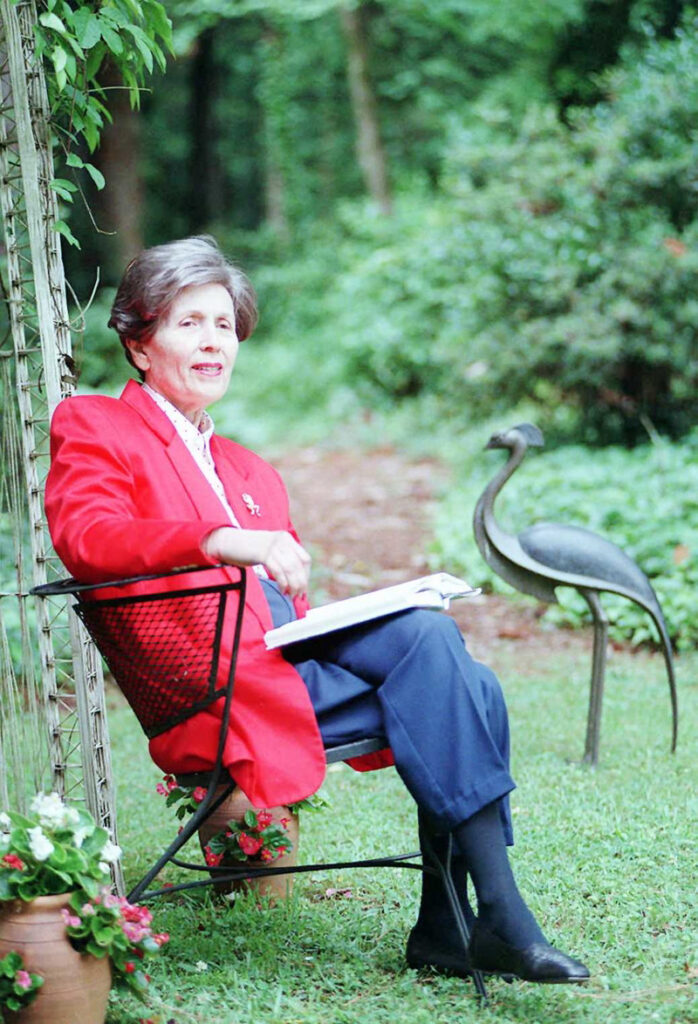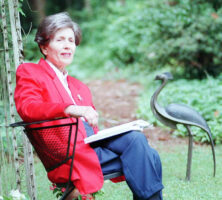Jane Hurt Yarn was a pioneering conservationist and environmentalist who single-handedly helped save thousands of acres of wild land in Georgia and around the nation. According to Georgia governor and U.S. senator Zell Miller, “No other single individual has done as much for conservation in Georgia as Jane Yarn.”
Jane Hurt was born on October 15, 1924, in Greenville, South Carolina, to Edna Brown and John Henry Hurt. She grew up in Scottsboro, Alabama, and attended St. Mary’s College in Raleigh, North Carolina. She conducted postgraduate work in landscape design at the University of Georgia in Athens. In 1944 she married Charles Yarn, a physician, and they had three children. The Yarns lived in Atlanta.
Yarn’s interest in the environment did not take hold until a family trip to Africa in 1967. Upon returning to Georgia, she served on the boards of both the Georgia Conservancy and the state chapter of the Nature Conservancy, and she organized coastal Georgia landowners against development. Her work played a key role in saving such barrier islands as Wassaw Island, Little Tybee Island, and Cumberland Island. Yarn’s most important contribution in these early years, however, may have been her successful organization of the state’s garden club members to stop a plan to strip-mine Georgia’s barrier islands for phosphate. Thanks to Yarn’s efforts, thousands of letters poured into Governor Lester Maddox’s office, and the Coastal Marshlands Protection Act, which preserves barrier islands and marshes as common land, was passed in 1970. It remains in effect to this day.

Courtesy of Atlanta Journal-Constitution.
Yarn was noted for her ability to work smoothly with both Democratic and Republican politicians. As she maneuvered in what was, at that time, essentially a “man’s world,” Yarn grew infamous for using her charm to hide a blistering wit, which caught many opponents off guard. According to Georgia governor and U.S. president Jimmy Carter, “I think all of us members of the state government felt that she was a strongly positive factor—sometimes even maybe an irritant, because when she got her mind set on something that should be good for Georgia, she was what some people would call overly persistent.” In recognition for her work, Yarn was recognized as Atlanta’s Woman of the Year in 1970 and was featured in the Atlanta Journal Constitution Magazine and Harper’s Bazaar.
Yarn served on President Carter’s Council on Environmental Quality in Washington, D.C., advising him on issues of environmental importance nationwide. In the waning days of the Carter administration, when the president was struggling around the clock with such weighty issues as the Soviet Union’s invasion of Afghanistan and the Iran hostage crisis, Yarn convinced him to sign legislation creating three National Marine Sanctuaries, including Gray’s Reef National Marine Sanctuary off Jekyll Island.
Following the close of the Carter administration, Yarn returned to Georgia, where she remained active in environmental causes. In the 1990s she suffered a second bout with breast cancer, which had been in remission since the 1970s. The illness claimed her life on October 18, 1995.
A 16,000-square-foot educational center at the Tallulah Gorge State Park in north Georgia bears Yarn’s name, as does a sixty-three-foot research vessel used for several years at Gray’s Reef National Marine Sanctuary. Having outlasted its usefulness as a science vessel, the R/V Jane Yarn was intentionally sunk in the summer of 2007 to create an artificial reef and fish habitat.
In further recognition of the role she played in saving the state’s natural treasures, Yarn was inducted into Georgia Women of Achievement in 2009.






